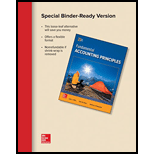
Concept explainers
Periodic Inventory system is an inventory system in which an organization updates the closing inventory balances in general ledger when it conducts physical inventory count. All purchases are recorded in purchase account and when physical counting is done then balance is transferred to inventory account.
There are several methods of calculating the value of inventory in closing stock which are as below:
FIFO method (First In First Out) is the most using method of
LIFO method (Last In First Out) is the method in which the quantity which purchase in last before sale transaction will be sold first. In closing inventory the quantity will be counted from the beginning inventory and purchase thereafter.
Weighted Average method is the most commonly used method after FIFO method. In weighted average the quantity of all purchases and beginning inventory is clubbed and then a weighted average rate is calculated and closing inventory is valued at weighted average rate.
Specific Identification method is the method in which the quantity is specifically identified that from which lot or purchases the closing stock is available and the closing inventory is valued by taking rates and quantities of that specific lot(s) from which closing inventory is available.
Under periodic method only at closing the inventory valuation is done and cost of goods is calculated as below:
Requirement-1
To Calculate:
In the given question we have to calculate the following details under periodic inventory system from the problem 6-3B:
- Cost of goods and quantity available for sale
Requirement-2
To calculate:
We have to calculate units in closing stock at month end.
Requirement-3:
To calculate:
We have to calculate cost of closing inventory using FIFO, LIFO, Weighted Average and Specific Identification method under periodic inventory system.
Requirement-4
To calculate:
We have to calculate gross profit under FIFO, LIFO, Weighted Average and Specific Identification method under periodic inventory system
Requirement-5:
To determine:
We have to determine that manager will prefer valuation method as it earns on percentage of gross profit.
Want to see the full answer?
Check out a sample textbook solution
Chapter 6 Solutions
Loose Leaf for Fundamental Accounting Principles
- Don't use ai. A company has the following data: Cash: $50,000Accounts Receivable: $30,000Inventory: $60,000Current Liabilities: $70,000a) What is the company’s acid-test ratio?b) Is the company in a strong liquidity position based on this ratio?arrow_forwardQuestion 5:A company has the following data: Cash: $50,000Accounts Receivable: $30,000Inventory: $60,000Current Liabilities: $70,000a) What is the company’s acid-test ratio?b) Is the company in a strong liquidity position based on this ratio?arrow_forwardQuestion 5: Acid-Test RatioA company has the following data: Cash: $50,000Accounts Receivable: $30,000Inventory: $60,000Current Liabilities: $70,000a) What is the company’s acid-test ratio?b) Is the company in a strong liquidity position based on this ratio?arrow_forward
- Question 4: Depreciation (Straight-Line Method)A company purchases machinery for $50,000. The estimated salvage value is $5,000, and the useful life is 10 years. a) Calculate the annual depreciation expense.b) What will the book value of the machinery be after 4 years?arrow_forwardInventory Valuation (FIFO Method)A company had the following inventory transactions during the month: Beginning inventory: 100 units @ $10 eachPurchase: 200 units @ $12 eachPurchase: 150 units @ $13 eachAt the end of the month, 250 units remain in inventory. Calculate the value of the ending inventory using the FIFO method. explainarrow_forwardNeed assistance without use of ai.arrow_forward
- Depreciation (Straight-Line Method)A company purchases machinery for $50,000. The estimated salvage value is $5,000, and the useful life is 10 years. a) Calculate the annual depreciation expense.b) What will the book value of the machinery be after 4 years?arrow_forwardA company has the following data: Cash: $50,000Accounts Receivable: $30,000Inventory: $60,000Current Liabilities: $70,000a) What is the company’s acid-test ratio?b) Is the company in a strong liquidity position based on this ratio?arrow_forwardDon't want AI answerarrow_forward

 AccountingAccountingISBN:9781337272094Author:WARREN, Carl S., Reeve, James M., Duchac, Jonathan E.Publisher:Cengage Learning,
AccountingAccountingISBN:9781337272094Author:WARREN, Carl S., Reeve, James M., Duchac, Jonathan E.Publisher:Cengage Learning, Accounting Information SystemsAccountingISBN:9781337619202Author:Hall, James A.Publisher:Cengage Learning,
Accounting Information SystemsAccountingISBN:9781337619202Author:Hall, James A.Publisher:Cengage Learning, Horngren's Cost Accounting: A Managerial Emphasis...AccountingISBN:9780134475585Author:Srikant M. Datar, Madhav V. RajanPublisher:PEARSON
Horngren's Cost Accounting: A Managerial Emphasis...AccountingISBN:9780134475585Author:Srikant M. Datar, Madhav V. RajanPublisher:PEARSON Intermediate AccountingAccountingISBN:9781259722660Author:J. David Spiceland, Mark W. Nelson, Wayne M ThomasPublisher:McGraw-Hill Education
Intermediate AccountingAccountingISBN:9781259722660Author:J. David Spiceland, Mark W. Nelson, Wayne M ThomasPublisher:McGraw-Hill Education Financial and Managerial AccountingAccountingISBN:9781259726705Author:John J Wild, Ken W. Shaw, Barbara Chiappetta Fundamental Accounting PrinciplesPublisher:McGraw-Hill Education
Financial and Managerial AccountingAccountingISBN:9781259726705Author:John J Wild, Ken W. Shaw, Barbara Chiappetta Fundamental Accounting PrinciplesPublisher:McGraw-Hill Education





